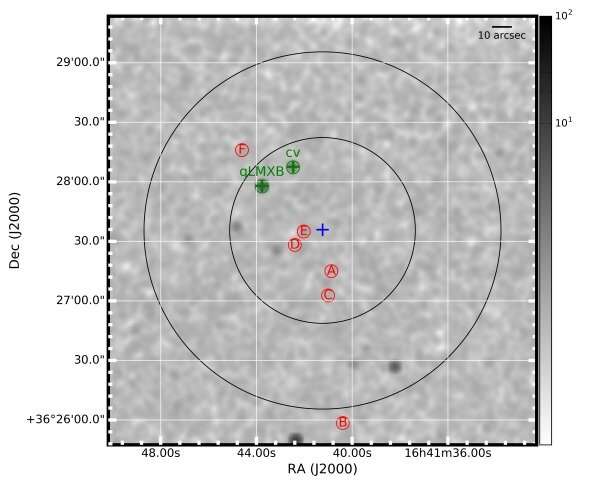Positions of the six pulsars in the GC M13, marked with red circles with letters. Credit: Wang et al., 2020.
Using the Five-hundred-meter Aperture Spherical radio Telescope (FAST), astronomers have detected a new binary millisecond pulsar (MSP) in the globular cluster NGC 6205. The newly found pulsar received designation PSR J1641+3627F. The finding is reported in a paper published February 14 on the arXiv pre-print repository.
Pulsars are highly magnetized, rotating neutron stars emitting a beam of electromagnetic radiation. The most rapidly rotating pulsars, with rotation periods below 30 milliseconds, are known as millisecond pulsars (MSPs).
Astronomers believe that MSPs form in binary systems when the initially more massive component turns into a neutron star that is then spun-up due to accretion of matter from the secondary star. Observations conducted so far seem to support this theory, as more than a half of known MSPs have been found to have stellar companions.
Now, a team of astronomers led by Lin Wang of CAS (Chinese Academy of Sciences) Key Laboratory of FAST in China, reports the detection of a new MSP in the bright globular cluster NGC 6205 (also known as M13), which is located some 23,150 light years away in the constellation of Hercules. The discovery was made as part of FAST observations of NGC 6205 that also monitored other pulsars in this cluster.
"In this paper, we present the discovery of the binary pulsar PSR J1641+3627F (M13F) and timing solutions of all the known pulsars in the GC M13," the astronomers wrote in the paper.
According to the study, PSR J1641+3627F has a spin period of approximately 3.0 milliseconds and an orbital period of 1.38 days. This means that it has the second shortest spin period and the longest orbital period among the six pulsars that have been discovered in NGC 6205 (the other five are designated PSR J1641+3627A to E).
FAST observations show that PSR J1641+3627F has a dispersion measure of around 30.4 parsecs/cm3. It was noted that this is close to the average dispersion measure value of other known pulsars in NGC 6205. The mass of the companion object is estimated to be around 0.16 solar masses, what suggests a white dwarf.
The research also found that PSR J1641+3627F is located at the edge of the cluster core and its spin period derivative is typical for MSPs in globular clusters. However, the system's eccentricity is, according to the astronomers, relatively small when compared to typical MSP-white dwarf systems.
In general, the researchers concluded that all the discovered binary systems in NGC 6205 have relatively low eccentricities when compared to typical globular cluster pulsars and the eccentricities were found to decrease with distance from the cluster core.
"This is consistent with what is expected as this cluster has a very low encounter rate per binary," the authors of the paper underlined.
More information: Discovery and timing of pulsars in the globular cluster M13 with FAST, arXiv:2002.05938 [astro-ph.HE] arxiv.org/abs/2002.05938
© 2020 Science X Network
























